

Excursions in Physics
PHY 3050C
First Hour Exam
September 20, 2002
Enter all your answers in the "scantron sheet" or the
"bubble sheet". Turn in only that sheet. Anything you write on this
exam will not be seen or used or considered or graded. Be sure your name and
SSN are on the "bubble sheet" you hand in. Be sure your name and
SSN are bubbled-in. Be sure your answers are recorded correctly.
For every question, also consider the following as a possible answer:
e) none of the above
Possibly useful information:
v = ![]() x /
x /
![]() t
t
a = ![]() v
/
v
/ ![]() t
t
v = vi + a t
x = xi+ vi t + (1/2) a t2
v = r ![]()
F = m a
F12 = – F21
w = mg
g = 9.8 m/s2 ![]() 10 m/s2
10 m/s2
For every question, also consider the following as a possible answer:
e) none of the above
1. Kinematics is a description of motion. Motion was first well understood
a) by Copernicus during the Industrial Revolution.
b) by Plato and the ancient Greeks during the Golden Age.
c) by Ptolemy in Egypt during the Ramses Dynasty.
d) by Galileo in Italy during the Renaissance.
2. Galileo was given a lifetime pension by the “city fathers” of Venice
because he introduced
a) the pendulum clock.
b) the water clock.
c) the telescope.
d) the astrolabe.
3. Galileo took a position as a professor of mathematics and taught
a) Euclid’s geometry.
b) Newton’s differential calculus.
c) von Liebnitz’ integral calculus.
d) Rubick’s cubism.
4. Velocity is the time rate of change of
a) acceleration.
b) speed.
c) displacement.
d) momentum.
5. Acceleration is the time rate of change of
a) velocity.
b) displacement.
c) distance.
d) momentum.
6. Acceleration might be described as telling
a) where an object is located relative to an origin or reference point.
b) how fast something is moving.
c) how fast something is getting faster.
d) how long an object has been moving.
7. What is the average speed of a car that travels 250 km in 5 h?
a) 1250 km/h
b) 625 km/h
c) 50 km/h
v = dist / time = 250 km / 5 h = 50 km/hd) 25 km/h
v = vi + a t
v = 0 + (4 m/s2)(5 s)
v = 20 m/s
d) 10 m/s
9. Consider a car that starts at rest and accelerates at 4 m/s2 for
5 seconds.
At that time, t = 5 s,
how far has it gone?
a) 100 m
b) 50 m
x = xi + vi t + (1/2) a t2
x = 0 + 0 + (1/2)(4 m/s2)(5 s)2
x = 50 m
c) 25 m
d) 12.5 m
10. Consider a train that has an acceleration of 3 m/s2. Initially,
at time t = 0, it has a velocity of vi = 20 m/s. What is its speed
at t = 4s?
a) 54 m/s
b) 42 m/s
c) 32 m/s
v = vi + a t
v = 20 m/s+ (3 m/s2)(4 s)
v = 20 m/s + 12 m/s
v = 32 m/s
d) 12 m/s
11. Consider a train that has an acceleration of 3 m/s2. Initially,
at time t = 0, it has a velocity of vi = 20 m/s. How
far has it traveled in those four seconds, or where
is it at t = 4 s?
a) 104 m
x = xi + vi t + (1/2) a t2
x = 0 + (20 m/s)(4 s) + (1/2)(3 m/s2)(4 s)2
x = 80 m + 24 m
x = 104 m
b) 88 m
c) 40 m
d) 24 m
12. Consider a ball that is thrown upward at the edge of a canyon with an initial
velocity of 20 m/s. Three seconds later, what is its velocity?
a) 30 m/s
b) 15 m/s
c) - 10 m/s
vy = viy + ay td) - 30 m/s
vy = 20 m/s + ( - 10 m/s2)(3 s)
vy = 20 m/s - (10 m/s2)(3 s)
vy = (20 - 30) m/s
vy = - 10 m/s
13. Consider a ball that is thrown straight upward at the edge of a canyon with
an initial velocity of 20 m/s. Three seconds later, where is it
located? Take its initial position, at the edge of the canyon, to be the origin;
that is, yi = 0.
a) 30 m
b) 15 m
y = yi + vyi t + (1/2) ay t2
y = 0 + (20 m/s)(3 s) + (1/2)( - 10 m/s2)(3 s)2
y = 60 m - 45 m
y = 15 m
vy = viy + ay t
vy = 0 + ( - 10 m/s2)(5 s)
vy = - (10 m/s2)(5 s)
vy = - 50 m/s
The minus sign, of course, means it is moving down.
y = yi + vyi t + (1/2) ay t2
y = 0 + 0 + (1/2)( - 10 m/s2)(5 s)2
y = - 125 m
The minus sign, of course, means it is down or below its starting position.
d) 250 m
16. A stone is dropped (from rest) from a bridge, high above a river. The stone
takes three seconds before it hits the river. How fast is it going
when it hits the water? (These should be sounding familiar
by now!)
a) 20 m/s
b) 30 m/s
vy = viy + ay t
vy = 0 + ( - 10 m/s2)(3 s)
vy = - (10 m/s2)(3 s)
vy = - 30 m/s
The minus sign, of course, means it is moving down.
c) 50 m/s
d) 100 m/s
17. A stone is dropped (from rest) from a bridge, high above a river. The stone
takes three seconds before it hits the river. How high is the bridge above the
water?
a) 10 m
b) 25 m
c) 45 m
y = yi + vyi t + (1/2) ay t2
y = 0 + 0 + (1/2)( - 10 m/s2)(3 s)2
y = - 45 m
The minus sign, of course, means the stone is down or below its starting position; so the bridge is above the river by 45 m .
d) 125 m
18. Projectile motion is a combination of
a) horizontal motion with constant, non-zero acceleration and vertical motion
with constant velocity
b) horizontal motion with constant non-zero acceleration and vertical motion
with constant, non-zero acceleration
c) horizontal motion with constant velocity and vertical
motion with constant, non-zero acceleration
d) horizontal motion with constant velocity and vertical motion with constant
velocity
19. Projectile motion describes the two-dimensional motion of an object under
the influence of gravity. The path that such an object takes is known as
a) an ellipse.
b) a hyperbola.
c) a parabola.
d) a semi-circle.
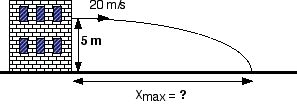
20. Consider a ball that is thrown horizontally from the edge
of a building with an initial velocity of 20 m/s. The ball is thrown 5
m above the driveway below. How far from the building does the ball strike the
driveway?
a) 5 m
b) 10 m
c) 15 m
d) 20 m
Before we can answer how far, we must first ask how long.
How long is the ball in the air? How long does it take the ball to fall the 5 m to the driveway?y = yi + vyi t + (1/2) ay t2
y = 0 + 0 + (1/2) ( - 10 m/s2) t2
- 5 = - 5 t2
1 = t
1 = t
t = 1 s
In that one second, how far horizontally does the ball travel?
x = xi + vx t
x = 0 + (20 m/s)(1 s)
x = 20 m
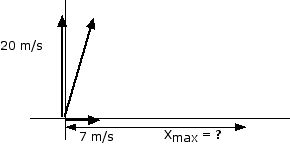
21. Consider a ball thrown from a level surface with an initial upward velocity
of 20 m/s and an initial horizontal velocity of 7 m/s. How
long is the ball in the air?
a) 1.0 s
b) 2.0 s
c) 4.0 s
How long does it take to get to the top (where vy = 0)?
vy = viy + ay t
vy = 20 m/s + ( - 10 m/s2) t
0 = 20 m/s + ( - 10 m/s2) t
t = 2 sThat is the time to the top so the total time is 4.0 s.
d) 8.0 s
22. Consider a ball thrown from a level surface with an initial upward velocity
of 20 m/s and an initial horizontal velocity of 7 m/s. Where
does it land? That is, measured from its initial position, where does it come
back to and strike the level surface?
a) 14 m
b) 21 m
c) 28 m
d) 54 mWe already know, from the previous question, that the ball is in the air for t = 4.0 s. In those four seconds, how far horizontally does it travel?
x = xi + vx t
x = 0 + (7 m/s)(4 s)
s = 28 m
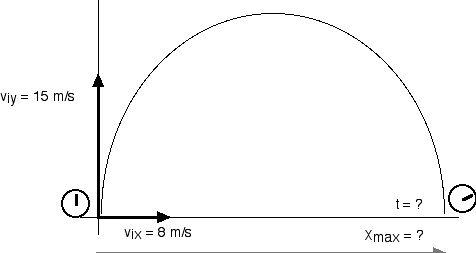
23. A golf ball is given a velocity of 8 m/s horizontally and 15 m/s vertically.
How long is it in the air, before coming back to its initial vertical
height? That is, how long is it in the air before striking the level
ground? (These should be sounding familiar by now!)
a) 1.5 s
b) 2.0 s
c) 3.0 s
How long does it take to get to the top (where vy = 0)?
vy = viy + ay t
vy = 15 m/s + ( - 10 m/s2) t
0 = 15 m/s + ( - 10 m/s2) t
t = 1.5 s
That is the time to the top so the total time is 3.0 s.
d) 4.0 s
24. A golf ball is given a velocity of 8 m/s horizontally and 15 m/s vertically.
How far, horizontally, does it travel before coming back to its initial
vertical height? That is, how far does it travel before hitting the level
ground?
a) 8 m
b) 12 m
c) 24 m
We already know, from the previous question, that the ball is in the air for t = 3.0 s. In those four seconds, how far horizontally does it travel?
x = xi + vx t
x = 0 + (8 m/s)(3 s)
s = 24 m
d) 48 m
25. Consider two children on a playground merry-go-round. One is near the center
and one is near the edge. The child near the edge
a) requires more time to make one revolution than
b) travels slower than
c) requires less time to make one revolution than
d) makes one revolution in the same time as the child
near the center.
26. If a Ferris wheel has a radius of 10 m and requires 20 seconds to make a
revolution, what is the linear speed of a passenger?
C = 2 ![]() r;
r; ![]() =
3.14
=
3.14
a) 0.78 m/s
b) 1.57 m/s
c) 3.14 m/s
v = dist/time = 2(10 m)/20 s
v = 2 (3.14) (10 m)/20 s
v = 3.14 m/s
d) 9.80 m/s
27. Newton's First Law of Motion states that, in the absence of a net force,
an object in motion will
a) eventually come to rest
b) continue in motion but slow down until it stops
c) continue in motion with the same speed
along the same straight line
d) continue along the same straight line with a decrease in speed
28. Newton's Second Law of Motion explains the cause of motion and may be stated
as
a) You can not touch without being touched.
b) All objects fall with the same velocity.
c) The acceleration of an object is proportional to the product of the object's
mass and the net force on it.
d) The acceleration of an object is proportional to
the net force on the object and inversley proportional to the object's mass.
29. Newton's Second Law of Motion explains the cause of motion and may be stated
as
a) The net force on an object is inversely proportional to its weight.
b) The net force on an object produces an acceleration that is proportional
to the time of action of that force.
c) The net force on an object is equal to the product
of the mass of that object and its acceleration.
d) The net force on an object is inversely proportional to the mass of the object.
30. Mass is a measure of
a) the volume of an object.
b) the size of an object.
c) how difficult it is to change the motion of an object.
d) the acceleration of an object.
31. The weight of an object is
a) another name forthe mass of an object.
b) the sum of all the forces on an object.
c) the force of gravity on an object.
d) always greater than the mass, even in a vacuum.
32. The net force on a 10-kg object, at rest, is
a) 98 N
b) 49 N
c) 9.8 N
d) zero
33. The net force on a 10-kg object, in free fall, is
a) 98 N
b) 49 N
c) 10 N
d) zero
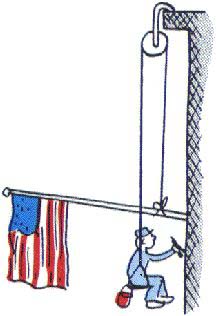
34. Harry the Painter has a weight of 500 N. When he is suspended as shown
in the sketch here, what is the tension in the rope?
a) 1000 N
b) 500 N
c) 250 N
d) 25 N
35. A force of 24 N acts on an object whose mass is 8 kg. This causes the object
to accelerate at
a) 2 m/s2
b) 3 m/s2
c) 4 m/s2
d) 6 m/s2
36. A car, with mass of 1,000 kg, accelerates at 2 m/s2. The
net force exerted on the car must be
a) 500 N
b) 1,000 N
c) 2,000 N
d) 3,000 N
37. The weight of a 1,000-kg car is
a) 500 N
b) 1,000 N
c) 2,000 N
d) 10,000 N
38. What is the mass of a fireman whose weight is
500 N?
a) 9.8 kg
b) 25 kg
c) 50 kg
d) 500 kg
39. A fireman, whose weight is 500 N, slides down a pole with
an acceleration of 2 m/s2. The forces that act on him are his
weight pulling him down and the force of friction pulling up on him to slow
him down. The force of friction must be
a) 100 N
b) 200 N
c) 400 N
Fnet = m a
Fnet = (50 kg)(2 m/s2)
Fnet = 100 N
Fnet = Weight - friction
100 N = 500 N - friction
friction = 400 N
d) 500 N
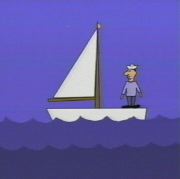
40. If a sailor drops a wrench from the top of a tall mast on a moving ship,
it will fall and hit the deck
a) in front of the base of the mast.
b) at the base of the mast.
c) behind the base of the mast.
41. Sir Isaac Newton
a) first discovered the Law of Falling Bodies while at the University of Pisa.
b) was a close friend of Liebnitz and encouraged his early development of calculus.
c) made great advances in Mechanics, Gravity, Optics,
and Mathematics.
d) used water clocks of his own invention to aid sailors in determining their
longitude.
42. Galileo
a) may be called the Father of Modern Optics.
b) wrote his findings in common Italian while at the University of Paducah.
c) may be called the Father of Modern Science.
d) wrote his findings about Gravity and discovered calculus.
43. The hallmark of Modern Science is that
a) theories are accepted or rejected based upon the background or reputation
of the scientists who propose them.
b) predictions of theories must be tested by and agree
with experimental results.
c) theories must have elegant mathematical equations.
d) predictions of theories must not contradict established authorities (such
as Plato or Pythagores).
44. When an object moves in a circle, Newton's Second Law of Motion, F =
m a, says that object must have a net force on it
a) only if its speed is changing.
b) directed toward its forward motion.
c) in the upward direction.
d) directed toward the center of the circle.
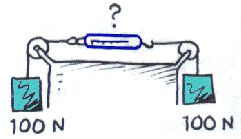
45. What value will the spring scale read in the system shown here?
a) zero
b) 50 N
c) 100 N
d) 200 N

46. In the sketch here, what value will the scale read if the little girl’s
weight is 250 newtons?
a) zero
b) 125 N
c) 250 N
d) 500 N
47. A moving object on which no forces are acting will continue to move with
constant
a) acceleration.
b) velocity.
c) centriptel acceleration.
d) displacement.
48. Weight is the force of gravity on an object. The weight of a one-kilogram
mass is
a) 2.2 newtons.
b) 5.6 newtons.
c) 9.8 newtons.
d) 19.6 newtons.
49. Sir Isaac Newton and Baron Gottfried Wilhelm von Liebnetz had a controversy
over which of them had discovered or invented
a) Rubick’s Cube.
b) Euclid’s Geometry.
c) calculus.
d) algebra.
50. The four fundamental forces of Nature are
a) gravity, friction, electricity, and atomic
b) gravity, electromagnetic, strong nuclear, and weak
nuclear
c) gravity, strong electric, weak electric, and atomic
d) gravity, friction, air resistance, and atomic